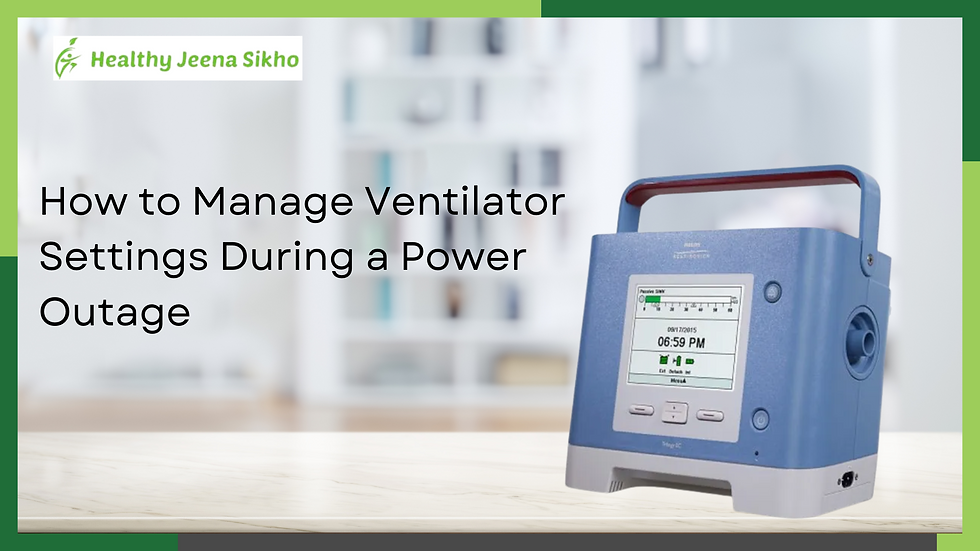How to Manage Ventilator Settings During a Power Outage
- Amit Verma

- Jan 9
- 4 min read

For individuals reliant on mechanical ventilation, a power outage transcends mere inconvenience and poses a serious risk. It is essential for patients, caregivers, and healthcare providers to understand how to effectively manage ventilator settings when electrical power is unexpectedly lost. This comprehensive guide will explore strategies for preparing for power outages, adjusting ventilator settings appropriately, and ensuring continued respiratory support during such events.
Here are some product recommendations.
Understanding Your Ventilator’s Power Backup Options
Modern ventilators typically come equipped with internal battery systems designed to take over in the event of a power failure. The duration these batteries can sustain the ventilator depends heavily on the specific model and the settings in use. For instance, higher ventilation pressures and rates may deplete battery life more rapidly than lower settings. Regularly checking the condition of these batteries and understanding their operational limits under different settings is critical for effective emergency preparedness.
Managing During Unplanned Power Outages
The first step during an unplanned power outage is to ensure that the ventilator has indeed switched to its battery backup. Immediately check the battery’s power level indicator to gauge available support duration. If the estimated duration is less than the expected time for power restoration, it’s important to implement a contingency plan, which may involve connecting the ventilator to a portable generator or relocating the patient to a facility with power.
Emergency Preparedness Strategies
Effective preparedness involves more than just having a backup power source. It requires a comprehensive emergency plan that includes maintaining a kit equipped with necessary supplies such as fully charged backup batteries, a reliable portable generator, and essential ventilator accessories. Additionally, compiling a list of emergency contacts—including the local power company, medical facilities, and a personal support network—is crucial.
Adjusting Ventilator Settings
To extend battery life during a power outage, consider lowering the ventilator settings that consume the most power, such as reducing the frequency of breaths provided per minute or decreasing the pressure settings if medically safe to do so. Always consult healthcare professionals to understand which settings are critical and which can be adjusted without compromising the patient's health.
Monitoring and Maintenance
Keeping the ventilator in optimal working condition is key to ensuring it functions properly during a power outage. This includes adhering to the manufacturer’s recommended maintenance schedule, routinely checking for any signs of wear or damage, and replacing filters and batteries as needed. Ensure that all connections are secure and that the external power supply is protected against surges when power is restored.
Additional Precautions
Precautions include instructing all caregivers on the operation of the ventilator and emergency procedures. Additionally, it is advisable to maintain charged communication devices to contact emergency services if needed, and to store manual resuscitation equipment, such as an Ambu bag, as a backup.
Utilizing Community Resources
Awareness of community resources can be a lifeline during a power outage. Many communities offer priority power restoration for homes where life-support devices are in use. Registering with these programs can ensure quicker service restoration. Local hospitals and emergency services can also provide support and advice in managing health equipment during extended outages.
Conclusion
Managing ventilator settings during a power outage is a critical skill for ensuring the safety and well-being of those dependent on mechanical ventilation. Through understanding the equipment, preparing for emergencies, and knowing how to optimize and adjust settings, caregivers can help mitigate the risks associated with power outages.
FAQs
1. What immediate actions should be taken when a power outage occurs?
Immediately ensure the ventilator is operating on battery power and check the remaining battery life.
2. How can I maximize my ventilator's battery life during an outage?
Consider adjusting settings that consume more power to lower levels, as long as they are still medically appropriate.
3. Are portable generators safe for ventilators?
Yes, but ensure the generator can provide stable, clean power suitable for medical equipment and that it's operated in a well-ventilated area to avoid carbon monoxide poisoning.
4. Should I notify my electricity provider about my dependence on a ventilator?
Yes, many utility companies offer priority restoration and other services for households with medical needs. Register with them in advance.
5. Can ventilator settings be adjusted without professional help?
Always consult with a healthcare provider before making any changes to ventilator settings.
6. What is the role of a manual resuscitation bag during a power outage?
A manual resuscitation bag (Ambu bag) serves as a manual backup to provide ventilation if the ventilator fails and cannot be powered.
7. How frequently should ventilator batteries be tested?
Test the batteries at least once a month and immediately after any incident that could impact their performance.
8. What essentials should be included in an emergency preparedness kit for ventilator users?
Include backup batteries, a portable generator, emergency contacts, essential medical supplies like sterile gloves and suction catheters, and basic first aid materials.
9. How do I prepare other household members to assist during a ventilator-related emergency?
Train all household members on how to use the ventilator, recognize alarms, and perform basic troubleshooting and emergency procedures.
10. Where can I find community support for emergency preparedness as a ventilator user?
Contact local health departments, power companies, and organizations like the American Red Cross for resources and assistance in emergency preparedness planning.
For more insights and information, feel free to explore our other blogs- Check out our related Articles




Comments